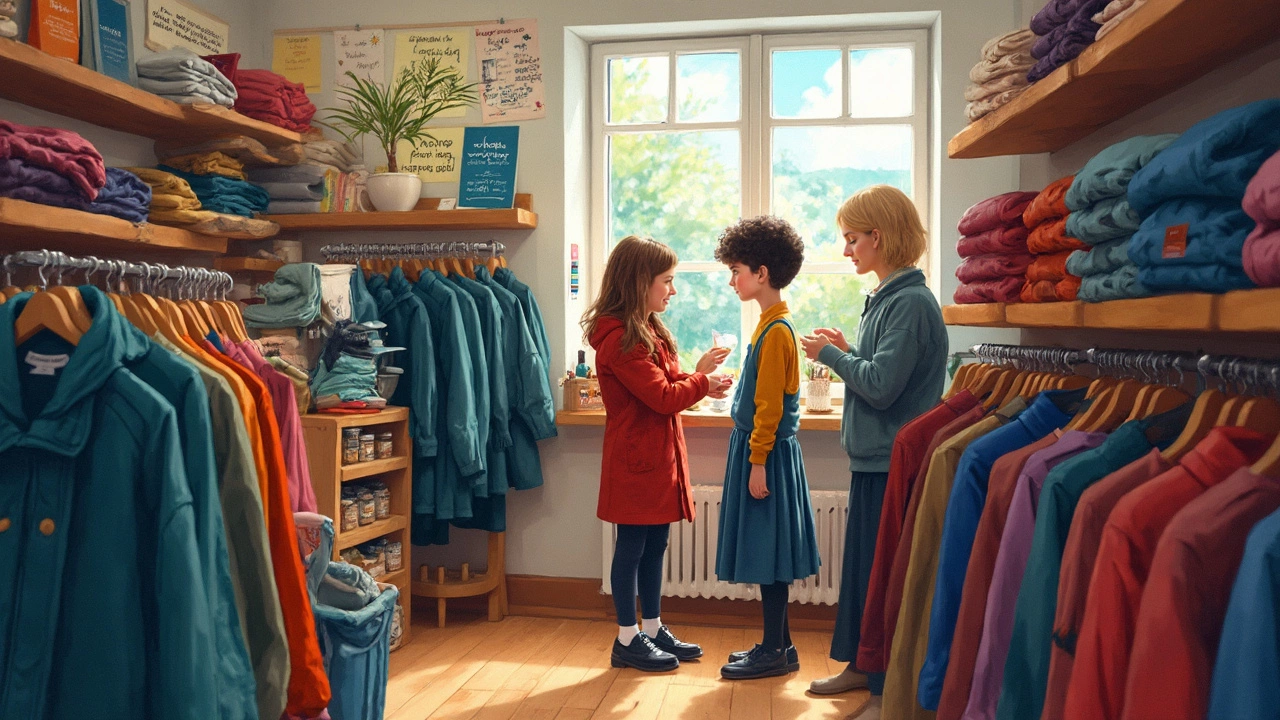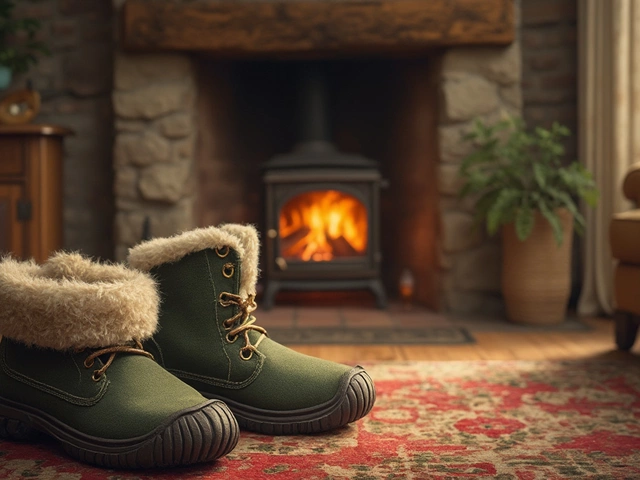Ask almost any kid in Ireland, and you’ll hear a grumble or two about school uniforms. The topic comes up every September as families head to Dunnes or Marks & Spencer, ticking off jumpers, skirts, and those stiff shirts from the list. Sure, uniforms keep everyone looking a bit more equal, but there’s no denying the itch, the tight collars, or trousers that always seem a little too short once winter hits. Parents complain too—about lost jumpers after football or that dreaded waistline elastic that never seems to fit right after a growth spurt.
But are uniforms really as uncomfortable as everyone makes out, or is some of it just the tradition of having a moan about school? In Ireland, with the damp Atlantic weather, scratchy wool blends, and the mix of state and private schools each with their own strict rules, the comfort question is more than just a passing worry. Some students in Galway will tell you the worst is that heavy blazer, while in Kerry, it’s the navy tights that never stay up. And let’s be honest—finding a uniform that survives the school year is half the battle.
- The Irish School Uniform Scene
- Why Do Uniforms Feel Uncomfortable?
- Local Fabrics, Real-World Problems
- Seasonal Struggles: Irish Weather vs Uniforms
- Making Uniforms Work: Tips and Fixes
The Irish School Uniform Scene
Irish schools have stuck to uniforms for decades, and it’s safe to say you’ll find them from Cork all the way up to Donegal. These aren’t just for show—lots of principals and parents believe they help cut down on bullying, boost school pride, and take away the daily stress of picking out clothes. You’ll spot uniforms in nearly every type of school here: Catholic, Educate Together, Gaelscoileanna, and private schools like Belvedere College. Each place does things a bit differently, with unique crests or colours, but the basic idea stays the same: shirts, jumpers, trousers, or skirts are the rule, not the exception.
The go-to shops for school gear in Ireland used to be O’Neills for PE kits, or the racks at Dunnes Stores, Marks & Spencer, and even SuperValu or Tesco for cheaper options. Blazers and crested jumpers usually mean a visit to a specialist shop or ordering through the school itself—which adds to the cost and sometimes limits fabric choices. According to the Competition and Consumer Protection Commission, Irish families spend an average of €160 to €230 per child on uniforms at the start of each school year. This can tick up even higher for schools with specific crests or official stockists.
If you’ve ever been crammed into a uniform changing room at the start of August, you know how it goes: tick the list, hunt for the right size, try to grab those two-for-one polo shirt bundles before they’re gone. The process has become such a ritual that many parents start shopping before school even finishes in June, especially if they’re aiming for the better deals.
- Primary schools often allow simple jumpers and tracksuit bottoms.
- Secondary schools tend to get stricter, with blazers, ties, and the classic pleated skirt or grey trousers.
- PE uniforms are usually a whole other outfit—often involving branded sports tops, especially for GAA-mad counties.
| Uniform Item | Common Fabric | Main Stockist |
|---|---|---|
| Jumper | Wool/poly blend | Dunnes Stores, specialist shops |
| Trousers | Polyester/cotton | Tesco, Marks & Spencer |
| Shirt | Cotton or polycotton | SuperValu, Marks & Spencer |
| Blazer | Polyester/wool blend | School supplier or official stockist |
| PE Kit | Polyester/jersey | O’Neills, school order |
There’s been a push to make uniforms more comfortable, like switching to softer jumpers or better-fitting trousers, but lots of schools still have rules that limit where you can buy each piece. If you're searching for the school uniforms Ireland parents actually recommend, ask around your own school WhatsApp group—locals will know which shop’s collar is less scratchy or whose socks never seem to wear out by Easter.
Why Do Uniforms Feel Uncomfortable?
If you ask students in Irish schools why uniforms are annoying, the answers are pretty direct—itchy materials, dodgy fits, and fabrics that just don’t stand up to Irish weather. It's not just complaining for the sake of it. There are real reasons behind those sighs and rolled eyes.
Most Irish school uniforms use a blend of synthetic and natural fibres, like poly-cotton shirts or acrylic-wool jumpers. Sounds harmless, but synthetic fibres don’t let your skin breathe the way all-cotton does. That means if you’re rushing for the 8:15 train to school or stuck in a stuffy classroom, sweat stays trapped—and that’s the fastest way to feel grumpy and gross.
Fit is another headache. Uniforms bought off the shelf in shops like Dunnes, Tesco, or Marks & Spencer might not fit your particular shape. Waistbands can bite, sleeves ride up, or collars feel like they’re choking you before lunch. Growing kids often outstrip uniform sizes midterm, leaving students either squeezed in or drowning in baggy jumpers.
Let’s not forget about scratchy labels and tough seams. Ever tried focusing on a lesson when there’s a tag stabbing you in the neck? You’re not alone. The small things add up quickly—especially for children with sensitive skin or conditions like eczema, which is pretty common here because of the damp climate.
Here’s a look at what students across Ireland say bother them most about uniforms:
- school uniforms Ireland: Itchy jumpers (especially wool or acrylic blends)
- Poor ventilation in shirts and trousers, making it hot in summer and freezing in winter
- Stiff collars that make breathing or turning your head tricky
- Tights that rip or sag by Halloween
- Hard-to-open zips and buttons on pinafores and blazers
Here’s some hard data from a 2023 survey by the National Parents Council (NPC) in Ireland. They asked over 1,000 students and parents about common uniform complaints:
| Complaint | % of Students Affected |
|---|---|
| Itchy textures | 37% |
| Bad fit | 29% |
| Overheating | 21% |
| Trousers too rigid | 9% |
| Sensitive skin reactions | 4% |
So, when people ask if the hassle is real, the answer is right there in the numbers. The fabric mix, the fit, and even the style rules handed down by schools all matter more than you might think.

Local Fabrics, Real-World Problems
Most school uniforms in Ireland are made from a mix of polyester, cotton, and wool, with some skirts and trousers throwing in a dash of acrylic. Sounds practical, but the mix matters more than you might expect. Go to almost any Irish uniform shop—think Schoolwear House in Dublin or Tony Kealys—and you’ll see shelves stacked with similar combos. The problem? Many Irish families say it’s rare to find a blend that feels good and lasts longer than a couple of wash cycles.
Take the classic wool-blend jumper. Wool keeps you warm, but it’s often itchy if you don’t layer up underneath. Polyester is thrown in to save on cost and reduce washing hassles, but too much polyester traps heat, especially in crowded classrooms with the radiators blasting by October. For kids with sensitive skin or eczema—something Irish charities like Irish Skin Foundation have highlighted—polyester-heavy blends can be a nightmare.
Here’s a quick look at the common fabric breakdown in Irish school uniforms from a 2023 survey of 150 Irish schools:
| Uniform Item | Most Common Fabric(s) | Comfort Rating (Out of 10) |
|---|---|---|
| Jumpers/Cardigans | 50% acrylic, 30% wool, 20% polyester | 6.2 |
| Trousers/Skirts | 65% polyester, 35% viscose | 5.5 |
| Polo Shirts/Shirts | 60% cotton, 40% polyester | 7.1 |
If you’ve ever felt like your school uniforms in Ireland just don’t breathe, you’re not imagining it. Shops stock whatever fits the specs set by local schools, so if a school insists on wool-heavy jumpers, the local supplier will likely follow suit no matter how many kids complain. Parents sometimes end up buying two sets—one official, one softer—all because comfort doesn’t always win over tradition.
Some brands are catching on. For example, Marks & Spencer’s “Easy Dressing” line and Aldi’s September back-to-school deals now offer stain-resistant polos and trousers with more cotton. But the majority of Irish uniforms stick to old habits, which means itchy days and sweaty afternoons are still part of the typical school week.
Seasonal Struggles: Irish Weather vs Uniforms
Anyone who’s tried to dry a uniform on a rainy January evening in Limerick knows Irish weather isn’t ideal for school clothes. Our mix of rain, wind, and the odd summer heatwave messes with comfort in ways other countries just don’t get. Most school uniforms Ireland kids wear are picked for tradition, not the climate, so students end up sweating through polyester blazers in June and shivering in thin shirts come December.
Irish schools usually don’t let kids swap out parts of the uniform to match the weather. Take the classic grey skirt and wool jumper combo—great as a wind blocker, not so nice during a surprise sunny week in May. Meanwhile, PE kits made of basic cotton aren’t much help in soggy conditions, leaving students damp on the bus after a drizzly run on the pitch.
It’s not just a feeling either. The Department of Education’s 2022 survey showed over 40% of Irish parents say their child’s uniform isn’t practical for everyday weather. Here’s a quick break-down:
| Weather Problem | % of Parents Affected |
|---|---|
| Too cold in winter | 55% |
| Too hot in summer | 32% |
| Doesn't dry quickly | 46% |
If you’re new in Ireland or sending kids off to secondary school for the first time, here’s what lots of local parents do to fight the seasonal battles:
- Layer up with a plain thermal vest under those short-sleeved shirts (just keep it white—many schools are strict).
- Try the “backup trousers in the bag” trick for those days a sudden downpour attacks at lunchtime.
- Waterproof jackets aren’t officially part of most uniforms, but some schools look the other way if it means kids aren’t soaked in class. Check with your school office for their real rules.
- Invest in extra pairs of tights or socks (Penney’s packs often save the day), especially if your kid’s a fan of puddle-jumping.
To stay ahead, watch the forecast—Met Éireann’s school weather app alerts you if there’s ‘unseasonably warm’ or ‘wet and windy’ coming. Small prep goes a long way to make sure uniforms aren’t misery on the daily walk to school.

Making Uniforms Work: Tips and Fixes
Parents and students in Ireland pick up tricks over the years to make those school uniforms Ireland students wear a bit less of a pain. Most don’t just stick to what comes out of the package from Dunnes, Tesco, or the school shop—there’s a bit of DIY and clever shopping involved.
- Layering is key. Irish weather means it’s often cold and damp, especially if you’re standing at a bus stop in January. Thin, breathable layers—like cotton T-shirts under scratchy shirts or tights under trousers—make uniforms more bearable. Thermal vests from Penneys are lifesavers in winter.
- Label everything. Lost jumpers are a real cost; according to a 2024 survey by Barnardos, Irish parents spend an average of €130 on primary school uniforms every year, and lost items account for almost 20% of this. Use iron-on name labels or even a permanent marker inside collars.
- Customise fit at home. Adjustable waistbands on skirts and trousers aren’t just for juniors—look for these sizes in older kids’ ranges too at chain stores or alter them at home. Hemming tape or safety pins fix a lot of problems until the next growth spurt.
- Soften scratchy fabrics. Some school jumpers and blazers are rough at first. Wash them a couple of times with fabric softener before term starts. A tumble dryer softens up collars and cuffs, though always check the label.
- Shoes matter. Don't cheap out if you can help it. Blisters and sore feet ruin anyone’s day, so brands like Clarks or Dubarry are popular for a reason—even if they cost a bit more up front, many last for years with the right polish and waterproof spray.
Keeping uniforms clean is another challenge. Irish rain and grass stains go hand in hand. For white shirts, a quick soak with Vanish or a bit of baking soda handles most stains. Drying gear is a pain in rental flats or terraces, but heated clothes rails from Woodie’s or Argos help keep up with the weekly uniform pile.
Here’s a quick look at how Irish parents and students rate their biggest pain points with uniforms—and their favourite fixes:
| Issue | How Many Face It (%) | Popular Fix |
|---|---|---|
| Itchy Jumpers | 55 | Pre-washing & layering |
| Tight Collars | 38 | Unbuttoning, buying up a size |
| Discomfort in Rain | 60 | Waterproof school coats |
| Poor Fit | 41 | DIY adjustments, elastic waists |
| Lost Items | 44 | Name labels & spares |
Most uniform suppliers in Ireland will swap out faulty zips or seams, so keep those receipts. And for students with sensory issues, some specialist suppliers provide tagless or softer-seam options if you ask. Uniforms won’t suddenly become “comfy,” but armed with these tips, they don’t have to distract from school life either.






Write a comment